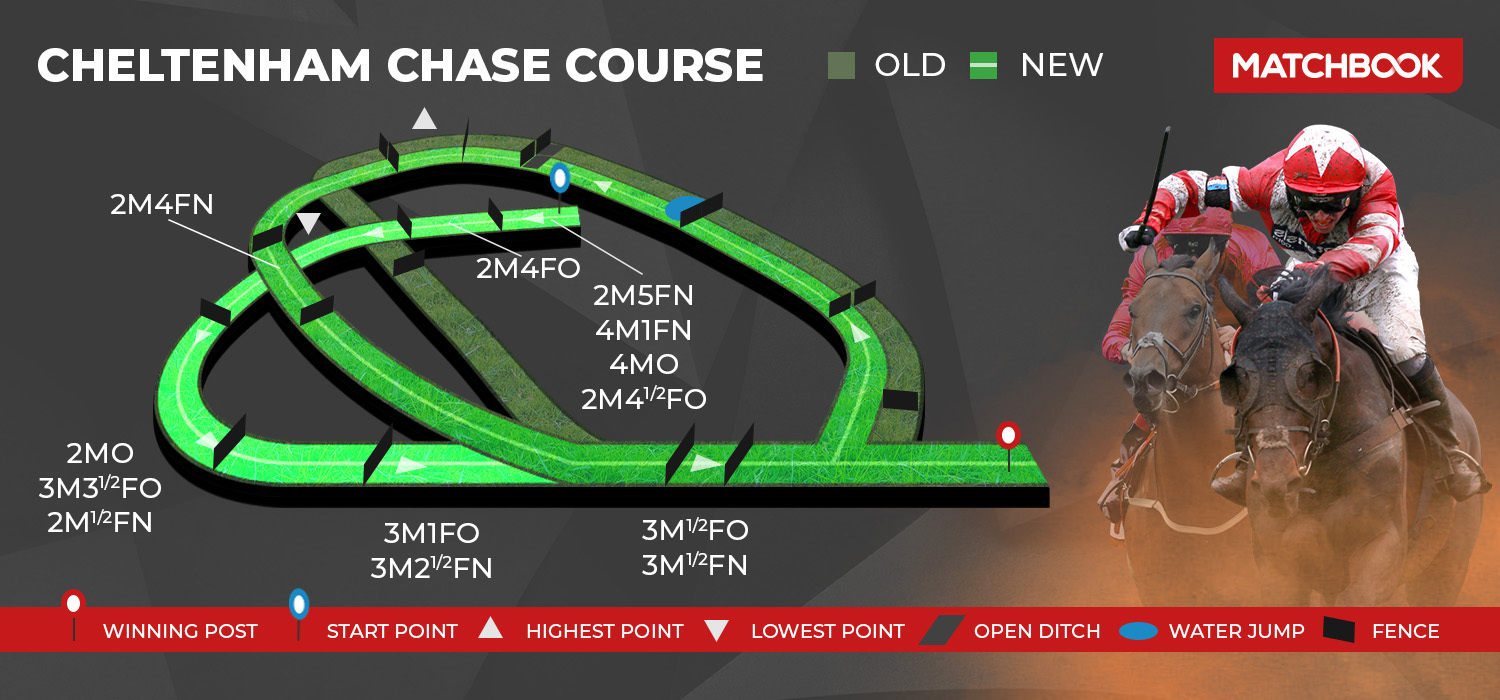
Cheltenham Trends analyst Matt Tombs is back with his third article looking at the difference between the Old and New Course…
Matt’s first two articles are available here – ante-post betting, trainer trends.
Every Festival, there’s much discussion about the differences between the Old and New Courses at Cheltenham.
Punters confidently claim that a horse will improve a lot for switching from one to the other.
So what are the differences, when are those differences most important, and just how different are they?
Episode 5 of our Cheltenham Previews is out NOW ⚠️@thespieler @mdeasy85 & @DanielHussey2 all share their picks at the current prices on Matchbook 👀https://t.co/P77oSO2ozy 🎧https://t.co/utKbKtOi4i 🎥 pic.twitter.com/Ho0IGBa2Xh
— Matchbook Betting Exchange (@TeamMatchbook) February 13, 2023
Course Layout
This is complicated because plenty of races don’t start on the ‘racecourse proper’.
Races like the Supreme start on a spur near the top of the hill, and intermediate trip races, such as the Ballymore, generally begin in the chute in the middle of the track.
That can have an impact – in the Supreme, they go downhill until setting out on the final circuit, which contributes to the traditional end-to-end gallop, rewarding horses with tactical pace that jump well and who are stayers at the trip. Marine Nationale looks the right type.
In the Ballymore, there is a big sweeping bend as they leave the chute, and a flight of hurdles comes up soon after it.
They, therefore, tend to go steadily, rewarding horses that settle and have a turn of foot – like Impaire Et Passe.
Despite that, most racing takes place on the ‘racecourse proper.’
For much of the way the 4 tracks are side by side – but when the horses leave the back straight and come across the top of the course and start downhill, the two courses diverge.
The Old Course turns much more sharply, whereas on the New Course they continue further up the back straight before turning.
When they turn for home, the comparative sharpness of the Old Course is repeated.
Where The 4 Tracks Are Situated
Where the tracks run side-by-side (broadly from the home straight until the end of the back straight), the Old Course is on the outside.
The hurdles track on the Old Course is the widest of all, with the chase track on the New Course on the inside.
Prestbury Park is a little like a cycling velodrome in that the flattest areas are on the inside, with the steeper gradient on the outer
If you’re looking at horses that have only run on, or shown their form at flat tracks, then that’s a bigger question mark for hurdles races on the Old Course like the Supreme than for chases on the New Course like the Turners.
As a rough rule of thumb, races run on the more undulating outer tracks can involve more tempo changes as there is more going up and downhill.
The inner tracks, which aren’t as undulating, tend to have a more continuous gallop which can make them more unrelenting.
That is part of the reason why the New Course is described as more ‘galloping’ and is also a reason why horses coming from off the pace have a better record on the New Course.

Most Of The Races Suit The Tracks
The programme split between the 2 courses plays a part. On the Old Course:
- 7 of the races are at around the minimum trip
- 3 are at intermediate trips
- 3 are at staying trips
On the New Course, that split is 3:5:6.
I think this is a good thing – the speed tests like the Champion Hurdle & Champion Chase are over the sharper tracks. That makes tactical speed crucial – it’s harder to make up ground as the good horses that jump well don’t get tired.
On the New Course, there are more staying contests, and the stamina-sapping nature of the tracks allows for more races to change as they come down the hill and then climb again to the line.
Each race needs looking at individually as does each renewal – it’s important not to badge a race as e.g. favouring front runners simply because its on the Old Course.
There are race like the Ultima on the Old Course where they often go too quickly and hold up horses have a good record. It would be no surprise to see last year’s winner Corach Rambler go well again, albeit the National is his main target.
Occasionally, races are moved between the Old and New Courses.
The Grand Annual is invariably run at a helter-skelter gallop and when run on the stiffer, galloping New Course between 1993 and 2020 saw many winners coming from off the pace.
Both winners since it was switched back to the Old Course have been prominently ridden, and I suspect such runners will be at an advantage going forward.
Of the ante-post market leaders, that would suit Aucunrisque & Haddex Des Obeaux more than Coeur Sublime & Third Time Lucki.
In-Running Moves
For in-running punters on the Matchbook Betting Exchange, there aren’t many flat areas at Cheltenham.
Ideally, you want a horse to make its move to gain track advantage when the ground is flattish.
You certainly don’t want a jockey pushing on uphill, where more energy is used per length gained and going downhill horses are often going nearly as fast as they can, so the energy used pressing on can produce less track advantage (going downhill can also be an opportunity to allow a horse to fill their lungs).
On the Old Course, the only really flattish area is in the back straight and that can be a good time to be watching who is travelling and gaining track position efficiently.
The New Course is less undulating, and there is a flatter area across the top of the tracks, which can also be a good opportunity to make a tactical move.
The final hurdle on the Old Course is quite near the finishing line now, which reduces the opportunity of flying the last, landing with momentum and mowing down the leader.
That makes races easier to predict in-running on that track.

 Join Now
Join Now
Horses That Jump To Their Right
All the tracks at Cheltenham are on the turn for much of the way, especially so on the Old Course.
Therefore they create more of an issue for horses that jump to their right than some left-handed tracks – such as Newbury where the jumping is done in straight lines.
Once horses are on the racecourse proper plenty of obstacles are taken on the turn, the issue generally being greater over fences.
Perhaps the biggest challenge for horses that go right is the fence by the Best Mate enclosure on the Old Course (there is no fence on that part of the track on the New Course).
The other fence really taken on the turn is the plain fence between the open ditches, 5 from home (there is a similar fence on the New Course.)
That’s now a concern for Jonbon after he jumped out to his right in the Kingmaker on a track (Warwick) where most of the fences, especially the 5 down the back straight, are jumped in straight lines.
The other issue for horses who shift right is coming into the home straight. This doesn’t present too big a problem on the New Course, but on the Old Course where the turn-in is sharper, the second-last fence comes up so quickly that it is liable to cause such horses to go right at it.
That’s a negative for Energumene who last year, by that stage being left with a simple task, was able to drift right out into the middle of the track.
I doubt he’ll have the luxury of covering so much extra ground at the business end this year.
Lack Of Hurdles In The Later Stages On The New Course
On the hurdles tracks, a big difference is the lack of jumping at the business end on the New Course, where there are just 2 hurdles in the final 7 furlongs.
This puts a real premium on stamina at the trip, especially in races like the Triumph, where if they go a strong gallop (less certain with the small fields these days), I could see a speedy-looking type like Lossiemouth getting outstayed.
Races often get settled on the long run from the second last to the last, as class tells at that stage (whereas you can often spot the winner with confidence well before then in hurdles races on the Old Course).


Rails
Horses that hang or lose concentration, especially younger horses, can benefit from a running rail on the inner.
If you are considering backing such a horse, (e.g. Chapeau De Soleil in the Bumper), you want to know where there is and isn’t a rail, (understanding that rails can be moved and so this can change between Festivals).
At one extreme, on the chase track on Friday on the New Course, there is an inside rail virtually the whole way round.
On the Thursday with fresh ground being kept for the Gold Cup that rail disappears, (except in the chute and round the main bends).
On the chase track on the Old Course, there are substantial sections, particularly after the fence in front of the Best Mate enclosure and up the back straight, where there is no inside rail.
Given the horses are generally less experienced, arguably, the presence or otherwise of a rail may be more critical on the hurdles tracks.
In fact, on both hurdles tracks, there are significant parts of the track with no rail. Crucially, unlike the chase tracks, there isn’t an inside rail in the home straight.
In races like the Supreme and Triumph, they can come to the stands side (i.e. outside rail) in the straight – jockeys have to decide whether to cover the extra ground to have the rail to help at the business end.
That tactic can be of most help in the Bumper where the horses are so inexperienced.
How Much Of A Difference Is There?
Understanding the differences between the 4 tracks can help you get an edge at the Festival.
That said, the differences are nuanced and shouldn’t be overstated – it’s nonsense to say that a horse can win on one course but not the other.
The difference between either course and, say, Leopardstown dwarfs the difference between the two Cheltenham courses, and the difference between them and Kempton is a degree bigger again.
Some horses will improve for switching between the two courses, but it’s a small piece of the overall puzzle when looking at a race.
Like trends or sectional timings, it’s vital not to get sucked into letting those nuanced differences dominate your thinking.
Matt’s first two articles are available here – ante-post betting, trainer trends.







